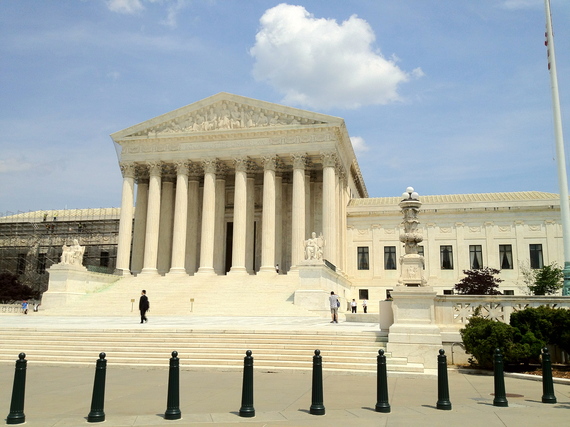Sixty years ago, on May 17, 1954, the United States Supreme Court issued its landmark Brown v. Board of Education of Topeka ruling, which declared that racially segregated public schools were "inherently unequal." Much like the question of segregation in the early 50's, today, marriage equality is approaching a critical point where the Supreme Court must decide.
In the decades since Brown, the Supreme Court has dealt with numerous controversial issues impacting the liberty of many Americans. These decisions affect the entire country, not just states where the actions are brought. They range from allowing people of different races to marry, to permitting women the right to terminate unwanted pregnancies and finding sodomy laws unconstitutional. In each instance, just like in Brown, even after the Supreme Court handed down its decision, the opponents of extending liberty were strident and unrelenting in their opposition. A clear example of this is the continued attempts by some state legislatures to circumvent a woman's right to choose.
The Supreme Court is not ignorant about where the public is on various questions. After all, the Justices are humans too. They read newspapers and watch the news. They do not live in a vacuum. Although they claim to be nonpartisan, it is clear each one has their own legal and political philosophies.
We have seen the court often dodge the ultimate issue raised in recent cases, particularly those dealing with LGBT rights. For instance, in The United States v. Windsor, the majority never answered the ultimate question of whether the freedom to marry was a fundamental right protected under the Equal Protection Clause of the Constitution. Some commentators have opined they did this because they learned their lesson from the public's reaction to their reproductive rights decision in Roe v. Wade. Getting ahead of the people lead to continued resistance and instability preventing the issue from being settled, once and for all.
In Brown, after many decades of racially separated schools, the Court found segregation inherently unequal and ordered integration. Similarly, the question of people of different races marrying had also been actively debated and litigated across the country. This led to a checkerboard of different state laws. Faced with these inconsistencies, in the 1967 case of Loving v. Virginia, the Supreme Court struck down all state misogyny laws. It was not until 2003, in Lawrence v. Texas, that the Supreme Court reversed its 1986 decision in Bowers v. Hardwick, which had upheld state sodomy laws, admitting "Bowers was not correct when it was decided, and it is not correct today." What is instructive about all three of these cases is that they were decided after much public education, media attention, direct action and political pressure.
We must view the question of marriage equality in the historical context of these cases. It was only 1993 when the Hawaii Supreme court found that denying gays and lesbians the right to marry violated its state constitution. This led to an immediate negative reaction in Hawaii where the state constitution was amended by popular referendum to only allow opposite-sex marriages, thereby overturning the Hawaii Supreme Court's decision. It also led, in 1996, to the passage by Congress of the Defense of Marriage Act (DOMA) defining marriage as the union of one man and one woman. In 2003, the Massachusetts Supreme Judicial Court ruled that barring same-sex couples from marrying violated its state constitution. Unlike Hawaii, the weddings began immediately. In response to these events, by 2004, thirteen states passed constitutional amendments banning same-gender marriage.
In the intervening 10 years since Massachusetts led the way, an additional 16 states and the District of Columbia have, through legislation and judicial decisions, embraced marriage equality.
Now the fight has moved to the Federal courts. It is likely the Supreme Court will be compelled to finally address the issue of marriage equality directly. It will do so with not only the addition of many states permitting same-gender marriage, but with a significant change in public attitude towards, not only their fellow LGBT citizens, but also the freedom to marry. The President and many leaders of government have evolved to the point where they can no longer support a ban on the marriage of any couples who love each other and are willing to make this important commitment.
Since the beginning of 2014, Federal or state judges in Oklahoma, Virginia, Michigan, Texas, Utah, Arkansas and Idaho have found bans unconstitutional. Judges have ordered Kentucky, Ohio and Tennessee to recognize same-gender marriages from other states. Appeals are pending or promised in all the cases.
To date, not one Federal Court of Appeals has found these bans to be constitutional.
As a result, the Supreme Court has not been asked to resolve any conflict between the Circuit Courts. This may soon come to end if the 4th Circuit in Virginia, or the 10th Circuit in Colorado, sides with the opponents of marriage equality.
The stage is set for the Supreme Court to put an end to this increasingly complicated situation. The implication to gay and lesbian married couples is apparent and the potential harm real and damage irreversible. Members of our Armed Forces are particularly vulnerable. A gay or lesbian military couple legally married in one state could be transferred to a military installation in another state that does not recognize their marriage. How will that family survive this uncertainty and being treated as second class citizens outside the walls of the base?
As we celebrate the 60th anniversary of Brown, we are reminded that much like segregation, now is the time for the Supreme Court to address the important issue of the " inherently unequal" ban on same-gender marriages. The table is set for the Court to unequivocally confirm that marriage is a fundamental right for all Americans, ALL.

